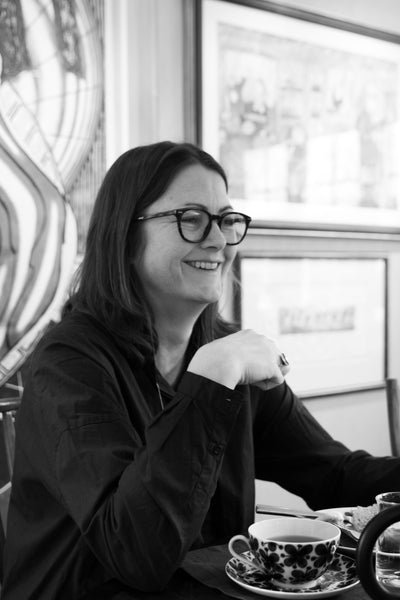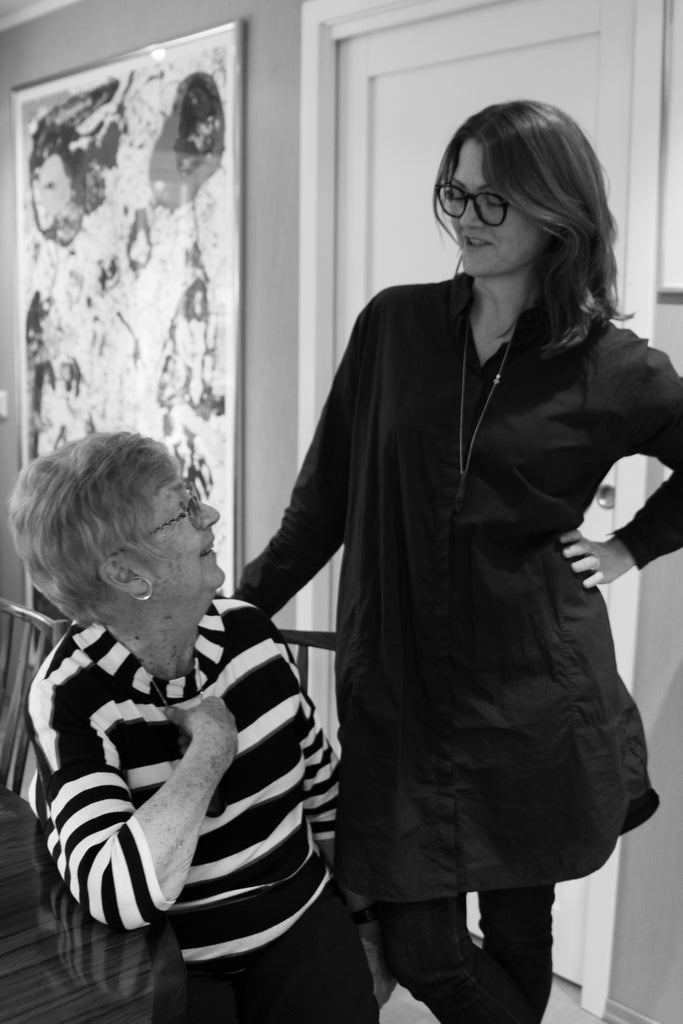
It is over 60 years since the term Norway Designs was created to promote Norwegian design and furniture in the USA. The founder was Per Tannum, a legendary figure in design and craftsmanship. The Norway Designs store at Stortingsgaten 28 in Oslo opened in 1957 and became a continuation of the exhibition in the USA, and since 1962 it has been run by his daughter, Liesel Boman and in 1996 her daughter Runa Boman took over. Since 1957, Norway Designs has been the mecca of Norwegian design and handicrafts.
Now you can get to know the women who have run Norway Designs for over 50 years a little better.
How did the Norway Designs adventure start for you?
Liesel: From around 1951, my father, Per Tannum, in collaboration with Toralf Prytz, began preparations for the sales exhibition "Norway Designs for living" in the USA. The purpose of the exhibition was to promote the export of Norwegian products. At this time I lived at home while I studied, and caught up with a part of what happened, but Per Tannum's activities and interests spread over so many fields that it was difficult to keep track of everything.
In 1957, he opened Norway Designs in Oslo, and I was called along with him to the exhibition ahead of the opening. After that I had a summer job in the shop.
Runa: I grew up in the store, so my adventure with Norway Designs has been with me all my life. When I was 13 I had my working week in the shop and after that I kept coming in to work during holidays, after school, on Saturdays etc. I was determined not to run a shop and trained as a librarian. But after a few years I found out that this manesje is mine, and started a separate department in Trondheim in collaboration with the store in Oslo. After that, the ball got rolling, and now I've been in this job for 23 years.
What were your visions for Norway Designs when you started?
Liesel: The vision was to present the best of Norwegian applied art. At the time, we were an internal jury of 3 people who assessed new products for the store. This included both industrially produced products, such as cutlery from Norsk Stålpress, enamelled corpus works from Cathrineholm and handwoven Solør Ryer, unique and serial glass from Hadeland and Magnor Glassverk, woven and printed textiles from small producers and works from many skilled ceramicists.
It was an exciting time where it was always important to focus on quality and design rather than sales successes. Another exciting aspect was that it took many years before turnover was large enough for the annual accounts to show positive figures. Our task was also to be a window to the rest of the world . We received public support for foreign buyers to use us as a showroom , where we mediated further contact with the manufacturers.
Rune: Norway Design's visions have always been my visions. The store was started by my grandfather Per Tannum and run by my mother . My grandfather's wish to convey good design, good quality and preferably in a Norwegian format has been my mantra for all these years. We have always worked towards these visions, both my grandfather, my mother and now me.
"For me, Norway Designs means - the place where I have spent my entire active professional life; i.e. about 47 years. I can count on one hand the days I haven't looked forward to coming to work. I am proud that we have never allowed ourselves to be tempted by good profits and turnover at the expense of design and quality. » - Liesel Boman
What is your earliest memory related to crafts and design?
Liesel: My father worked tirelessly to promote good design in Norway, and thus I have always been surrounded by this in many ways. So the answer is perhaps that I don't have a concrete memory, but that I've had it with me all my life.
Runa: As I remember it, I have always been surrounded by design and handicrafts. I have many memories from Norway Designs when I was growing up, but what stands out most clearly are the visits to all the different workshops that were part of PLUS in the old town of Fredrikstad. The textile print shop and the glass cabin are perhaps the strongest , especially how something is formed from almost nothing to suddenly become a completely concrete object. That transformation has fascinated me for as long as I can remember.
Which design object is your favorite among all who have been/are at Norway Designs?
Liesel: It must be the ear loops that Tone Vigeland designed and which were produced in the silver room in PLUS. They depend on me every day and have done so for almost 60 years.
Rune: Choosing just one favorite is not possible , there are many objects that have the status of favorite . But I know that good design and quality means that an object lives with me for a long time. Much of what I have at home I have carried with me for many years - precisely because it lasts both in quality and in shape . Which things are a favorite vary , something is always there and something gets new life after having a stay . Right now there is a lot of ceramics that pleases me in my everyday life, both the plates by Anette Krogstad and the picture I have on the wall made by Ragnhild Wiik . Also, the Chaco cutlery that I use every day, and the Tiki sofa - which Andreas Engesvik has designed for Fogia . And, not least – blankets from Røros Tweed – these are in use every day all year round. I am also very fond of my jewellery, for the past few years I have worn around my neck that Kristine Bjaadal has picked at the top of Grefsenkollen.

Which female artisans/designers should you keep an eye on now?
Liesel: I'm not that up-to-date anymore on today's designers. However, if I were to name some female designers who have played a major role in Norwegian design, I would highlight Benny Motzfeldt, Sigrun Berg, Tone Vigeland, Kari Fronth and Dagny Hald. It could certainly have been filled with many more, but these stand out to me as important shapers in their respective fields.
Runa: There are so many talented female designers and artisans on the field now and the danger of forgetting someone who should perhaps have been on the list is great.
Kristine Five Melvær has completed many projects both in Norway and internationally. The same applies to Kristine Bjaadal, Runa Klock and Vera&Kyte. The border between design and handicraft is also much more fluid than it was before, I think Anette Krogstad lives well in the middle of nowhere, the same applies to Odd Standard, the small factory that makes ceramic tableware and is run by Constance Gaard Kristiansen and Tonje Sandberg . It is exciting to follow Kaja Solgaard Dahl's future plans, and also Stine Aas. The list could have been much longer, because there is a lot of interesting happening, both among female and male designers in Norway today.
What is the most positive thing about being a female leader?
Liesel: Forget female, the most important thing for me is to be a good leader. And - I wish I had learned more about leadership before I was given such a task.
Rune: For me, being a leader is not linked to gender . I am a leader, and it is a task I have a very humble relationship with. My task is to lead a company rich in tradition within the framework that has been determined and I also have responsibility for ensuring that all my excellent employees have a good and safe workplace to go to . It is exciting, challenging, fun, meaningful and occasionally very difficult .
" Norway Designs is a place you can come to be inspired, to buy a gift for yourself or someone else you love, to find the best from Norwegian designers or learn something new from one of our great employees. » - Runa Boman
What is the best advice you have received?
Runa: It has to be true to yourself, listen to experienced mountaineers and don't be tempted by bestsellers. Also, be honest and care about those around you.
What does success mean to you?
Liesel: If you succeed in something you have worked on and believe in, then you are successful.
Runa: Success for me is not measured in numbers. I am concerned with the bottom line so that my company can continue to live, not to bask in the glory. My success is that, together with my employees, I manage to run the store from year to year, that we manage to stick to the objectives we want and that my employees and I thrive with that .

Who do you look up to?
Liesel: I look up to my father, Per Tannum. He was a true idealist. But he was also a dictator - which he may have to be in order to implement everything he believed in.
Rune: I look up to everyone who works every day for things they believe in. Then I think of both those who take care of people in vulnerable situations , those who dare to invest in order to reach a goal, and for example, designers who have a vision and desire to create fine objects that they want to put out into the world . Passionate and brave people - I find both very inspiring and admirable.
What advice and tips do you have for female managers?
Liesel: Again; forget about women and instead focus on being a good leader. Remember to listen to those around you and what they have to say.
Runa: Be yourself and listen to your employees and other partners. There is always a lot to learn if you keep your eyes and ears open.
What are your visions for Norway Design's future?
We want Norway Designs to have the same goals as we have always had:
- We will promote good Norwegian design and handicrafts.
- We will make our everyday life better because we convey objects that make the world a more beautiful and better place.
- We will delight and surprise our customers and sell things that we believe in.




